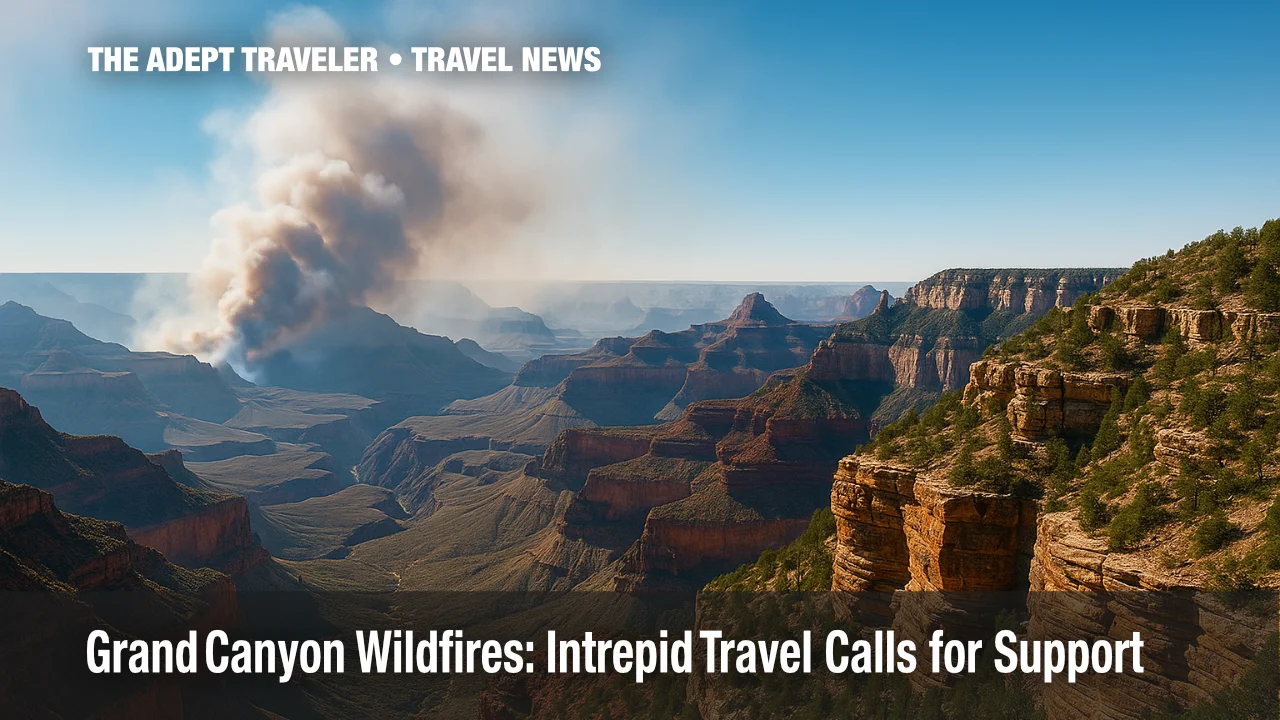Grand Canyon Wildfires: Intrepid Travel Calls for Support

Wildfires are again reshaping travel plans at Grand Canyon National Park. The lightning-sparked Dragon Bravo Fire has destroyed the historic Grand Canyon Lodge, burned more than 5,000 acres, and forced a full North Rim closure for the rest of 2025. Intrepid Travel and its Wildland Trekking unit say South Rim trips will proceed, but routes are being adjusted. The company is urging travelers to keep visiting-and donating-to support park conservation and the communities that rely on visitor spending.
Key Points
- Dragon Bravo Fire tops 5,000 acres; North Rim closed for 2025
- South Rim remains open; Intrepid rerouting about 30 tours
- Why it matters: Park fees and local spending fund long-term recovery
- Intrepid asks guests to donate to Grand Canyon Conservancy and NPCA
- Travelers advised to monitor official updates 48 hours before departure
Snapshot
The Grand Canyon wildfires-chiefly the Dragon Bravo Fire and smaller White Sage Fire-are concentrated on the Kaibab Plateau above the Colorado River. All North Rim facilities, inner-canyon corridor trails, and State Route 67 are shut. On the South Rim, viewpoints, campgrounds, and visitor services operate as normal, and commercial flights into nearby airports continue. Intrepid's affected backpacking and lodge-based tours have been shifted south of the canyon or postponed, with guests offered alternative routes that avoid smoke and active fire zones.
Background
Lightning-caused conflagrations are part of Grand Canyon ecology, yet drought, high winds, and accumulated forest fuels have lengthened fire seasons and increased fire intensity. The last major North Rim blaze of this scale, the 2006 Warm Fire, closed 40 miles of roads and trails. Today's Dragon Bravo Fire mirrors those conditions, expanding rapidly after July 4 ignition despite an initial confine-and-contain strategy. Fire managers shifted to full suppression after gusts topping 40 mph overwhelmed containment lines and leveled the 95-year-old Grand Canyon Lodge-a loss that underscores the vulnerability of heritage structures to climate-driven extremes.
Latest Developments
The situation evolves daily. Below is a concise round-up of the most relevant updates for travelers.
Size and Status
As of July 16, the Dragon Bravo perimeter exceeds 5,800 acres with 22 percent containment. Crews are focusing on structure protection near Roaring Springs and preventing spread toward the canyon's Inner Gorge.
Visitor Logistics
Intrepid and Wildland Trekking have rerouted roughly 30 departures through November. Guests are notified 48 hours before travel with revised meet points, typically shifting hikes to South Rim trails such as the Bright Angel and South Kaibab or to lesser-known routes along Desert View Drive. No additional fees apply.
Conservation and Donations
The Grand Canyon Conservancy has opened an emergency fund for trail repair, habitat restoration, and future fire-mitigation projects. The National Parks Conservation Association is lobbying for increased federal wildfire resilience funding. Intrepid pledges to match guest donations up to $25,000 this season.
Analysis
For most visitors, a South Rim itinerary still delivers classic canyon panoramas, ranger programs, and gateway-town amenities. Lodging remains tight, so book early and reconfirm reservations 48 hours out. Air quality fluctuates with wind shifts; carry an N95 mask if sensitive to smoke. Hikers should expect detours around Havasupai Gardens and Phantom Ranch until trail assessments deem them safe. Traveling with an operator such as Intrepid streamlines these logistics, ensures compliance with park advisories, and injects needed revenue into gateway communities like Tusayan and Williams. Independent travelers can help by buying locally, practicing Leave No Trace, and respecting fire-related area closures.
(For a deeper planning primer, see our guide to Grand Canyon National Park.)
Final Thoughts
Grand Canyon wildfires are a stark reminder that cherished landscapes need both stewardship and steady visitor support. By staying informed, traveling responsibly, and donating where possible, travelers help fund trail repairs, habitat restoration, and firefighter readiness. Keep plans flexible, heed park alerts, and remember that every respectful visit contributes to the canyon's long-term recovery-ensuring future generations can marvel at its vast, fire-shaped horizons while learning how to coexist with Grand Canyon wildfires.
